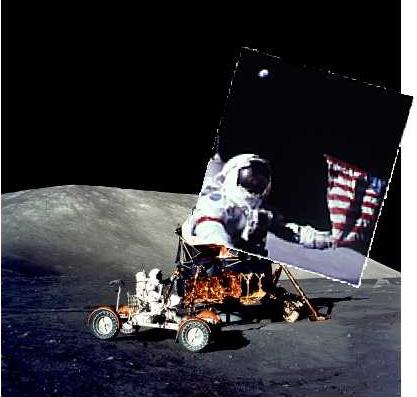earth in the frame







|
|
|
Because the west slope of the South Massif (at the right in Figs. 1 and 2) is a fairly straight line, and the foreground demarcation is similarly linear, Mr. White's contention that a perfect match can be made with his cropped version of the inset is incorrect. In fact, if the inset is made larger or smaller, it can actually "fit" several places in the larger image. Mr. White has made no attempt to normalize the scale of the two photographs.
Fortunately with the full image we have another point of correlation which can help us find the correct relative scale. If the full frame of the inset is placed where Mr. White has placed it, the portion of the ridge line at the lower left does not lie anywhere close to the ridge line in the larger photo. This is conclusive evidence that Mr. White's superimposition is not correct.
|
Fig. 3 shows a more defensible superimposition. We are able to identify certain prominent features in the South Massif and use them as registration aids. Further, we make use of the entire inset frame. The combination of the correlations identified in the caption strongly suggests that this is a more accurate registration of these photos. All visible elements of the ridgeline and the foreground demarcation line up. Since features (A) and both features (B) form a triangle, it is impossible for there to be more than one such correlation. Further, both features (B) and feature (C) -- which by itself provides both collocation and slope -- form a second triangle that establishes a single registrational solution. There is a high degree of confidence in this superimposition.
The portion of the rotated photograph (AS17-134-20387) that contains the image of the earth is now outside the frame of the photo containing the LM and LRV, confirming that the earth image should not appear in that photograph, and that this does not constitute a point of inconsistency between them.
Mr. White has had similar problems normalizing the scale of Apollo photographs he compares directly.

 In the larger photograph
in Fig. 1 no image of the earth appears. But the inset, which shows
the same mountain, includes an image of the earth. A portion of the
foreground occurs in the inset, allowing us to precisely superimpose
these images. The earth should appear in the larger photo, but it
does not, proving that they were not taken on the moon. The image of
the earth in the inset was obviously added optically later. [Jack
White]
In the larger photograph
in Fig. 1 no image of the earth appears. But the inset, which shows
the same mountain, includes an image of the earth. A portion of the
foreground occurs in the inset, allowing us to precisely superimpose
these images. The earth should appear in the larger photo, but it
does not, proving that they were not taken on the moon. The image of
the earth in the inset was obviously added optically later. [Jack
White]


